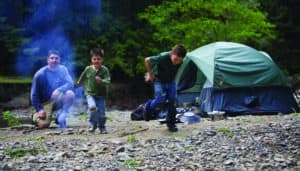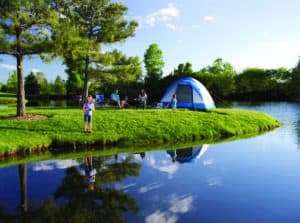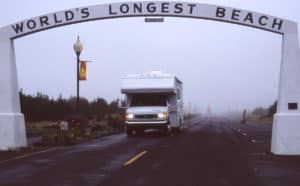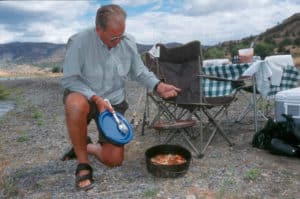Ah, I remember those family adventures like they were yesterday, even though 40 years or so have passed. Sometimes, the small Airstream trailer got the nod for a camping trip. Other times, an old-school canvas tent from J.C. Higgins was home.

There’s countryside full of great outdoor adventures awaiting your family. Combine your trip with some hunting or fishing, and you are sure to have happy campers.
Pop would load the family in the truck and point the rig to… well, somewhere. I’d be squirming in the backseat about to burst with excitement, regardless of the destination. One weekend it would be a campsite on Lake Erie highlighted by fishing and cooking our fresh catch over the campfire. Another weekend would be spent exploring the Wayne National Forest in southeast Ohio. We might also head to Pymatuning Lake on the Pennsylvania border for a little added fishing before school started back.
Regardless of where we landed, an adventure was about to occur whenever the Old Man announced, “Load up. Let’s go camping!” When I think back, even after all these years, at the fond memories our family made together, I wonder why every family doesn’t take a camping trip every chance they get.
There’s no denying the fact camping is great fun. The only way to make it more enjoyable is to do it as a family. And, if you can throw in the option for a laid-back fishing trip or a little hunting, that’s all the better. A nice thing about family style camping in this modern day and age is that it’s comfortable and easy. Or rather, it’s as easy as you want it to be. Remember though, as a parent or guardian, it’s your position, first and foremost, to make certain your young charges are safe in the outdoors. Beyond that, all they need is a taste of Mother Nature’s fine entertainment, and a good hot meal cooked, with their help, over the fire. Provide those simple pleasures, and you’ll be batting a thousand.
Here are steps to help ensure your family adventure into the great outdoors is a success, whether it’s your first time afield or you’re simply out to add to your family’s camping memories.
Get The Right Gear
Some of you reading this already own and use a camp trailer. Or maybe you and the family have some well-worn primitive camping gear. The primitive camping basics include a tent, sleeping bags, lantern, and a Coleman double-burner cook stove. If either are the case, I applaud you. If I were there, I’d give the campers’ secret handshake. If you’re brand new to camping, do not despair. You need not break the bank in order to outfit yourself and the family for an outdoor journey.

When some fishing is involved during a family camping trip, you will have kids giddy with excitement and a trip sure to provide lifelong memories for everyone.
Before you begin assembling gear, you’ll need to decide what type of camping you’d like to do. Maybe you wish for the conveniences of a recreational vehicle (RV). Perhaps a small easily towed camp trailer is more to your liking. Or, and my personal favorite, maybe it’s a tent your long for, a night spent under the stars, with only a small hardwood fire to chase off the chill. Fortunately, any and all of these can be obtained rather easily, and in many cases, inexpensively.
Many businesses across the country specialize in renting RVs to those looking to test the waters. Camp trailers, too, can be rented and tried before deciding whether or not a purchase is in order. Even camping equipment can be rented.
There are many rental options. I’ve used the folks at LowerGear Outdoor Rentals and Sales (lowergear.com; 480-348-8917). They make available a long list of very reasonably priced camp gear for rent, including tents, outdoor cooking supplies, backpacks, sleeping bags and even lanterns. Items can be shipped right to your door. It’s definitely worth a look-see, and without question this route is much less expensive than buying a pile of gear before you know whether camping is an activity your family will take to.
If you don’t want to rent and are frightened by the cost of buying new camping gear, there are many outlets for bargain shopping to find your camping gear. Garage sales, flea markets, and estate sales are excellent places to find quality outdoor items for pennies on the proverbial dollar. Websites like Craigslist.com and the Outdoor Marketplace at www.gon.com often have a treasure trove of softly used items at reasonable prices. Some good Google research will lead to other resources. As always, use common sense and a buyer’s caution when purchasing from unknown sellers.
Decide on a Destination
The United States is unique is so many aspects, yet few are more amazing than our endless variety of breathtaking natural resources. It’s shame how many Americans fail to utilize our freedom to travel to any of those places whenever we choose. My advice when deciding where to go camping, and this is directed at you novice family campers, is to make that first journey close to home.
Pick a spot within 100 miles, or no more than a reasonable half-day drive from your door. There are two reasons. One, you don’t want your family cooped up in the vehicle for 10 hours before setting up camp. Trust me, it’s a recipe for collective crabbiness. And second, you want to arrive at your campsite with plenty of daylight left to get your new home away from home completely set up before nightfall.
Come dark, the only things left to do should be to poke at the campfire, eat S’mores, listen to the coyotes call, and brag about the huge fish you’re going to catch the next morning.
What location should you pick for your camping trip? Fortunately, the Internet is crawling with information. State parks, national parks, private campgrounds, and millions of acres overseen by the Bureau of Land Management exist in all corners of the country. Thanks to the web, it’s a matter only of going online and sorting through the search results.
Once you’ve narrowed your search to perhaps two or three possibilities, it can be quite helpful to call and speak with a ranger or other official on the property. Don’t be shy about asking questions. How’s the fishing nearby? What kind of fish? Is it child-friendly fishing? What type of restrooms or shower facilities, if any, is available? Do I need to make reservations? I’d also recommend searching for a local web forum where users post comments and reviews. Surf the web, and then make a few calls and ask plenty of questions.
Organize Activities, But Just a Little
Good meals lie at the heart of every good camping trip. This is especially true for families, particularly those with smaller children. Before leaving home, decide how long you’re going to stay in camp, and what meals for breakfast, lunch, and dinner might work well. Keep the kids in mind always, and plan a menu that includes them not only as consumers, but as outdoor chefs as well. Hotdogs on a stick with baked beans? Perfect. Bacon, eggs, and pancakes on that double burner stove? Absolutely. When eaten outdoors, food doesn’t have to be fancy to be fantastic. Make preparing it fun, and it will taste even better.
As with the menu, plan activities to keep the family entertained, but don’t create an inflexible itinerary. It’s important to go with the flow, so to speak. A little fishing is always advisable. If you, say, decide on a camping trip to Missouri’s Lake of the Ozarks in September, perhaps a little squirrel hunting in the morning followed by some crappie fishing in the afternoon. Make sure there’s a mid-day nap, of course. Oh, and that’s an essential part of every successful camping trip with the kids. Naps. Separate tents, naturally.
Five Great Family Camping Destinations
The potential destinations for a family camping trip are literally endless in this great country. Explore and find your own favorite, but also put our five favorites on your to-do list.
The Long Beach Peninsula – Long Beach, Washington

The arc at the entry means your family is about to experience one of the author’s favorite camping destinations—the Long Beach Peninsula on Washington State’s coast.
This truly is one of my favorite places on the planet! The Long Beach Peninsula on Washington State’s coast is 28 fun-filled miles of something to do all the time.
If it’s primitive camping you’re looking for, try Fort Canby State Park at the far south end of the peninsula. Here, you have five-minute access to superior salmon fishing, plus plenty of room to stretch your legs.
Charter boats for salmon, bottom fish, albacore tuna (in season), and sight-seeing can be hired at the nearby Chinook boat basin.
In the fall, there’s duck and goose hunting available, too. Oysters, steamer clams, go-carts, antique/curio shops, kite flying competitions, you will find all of it and more on the Long Beach Peninsula. For more information, visit http://funbeach.com.
The Black Hills – Deadwood, South Dakota
The Black Hills actually ties the Long Beach Peninsula for the title of my favorite place on the globe. In the spring, Merriam’s turkeys shatter the dawn with their incredible gobbles. During the summer, this is trout angler’s paradise with a myriad streams and small lakes that dot the national forest. Don’t forget Custer State Park and Spearfish Creek, either. During the fall, the thoughts turn to hunting, whether with a weapon or a camera, for whitetail deer, elk, and yes, even mountain lions. The town of Deadwood offers something for all ages, including the wonderful Days of ’76 Campground located at the east end of town. Those wanting to rough it can camp in the Black Hills National Forest. For details on the area, visit www.deadwood.org.
Pymatuning State Park – Linesville, Pennsylvania
As I was growing up in the northeast corner of Ohio, every spring my father would take me to Pymatuning Lake on the Ohio/Pennsylvania border for some of the country’s finest crappie and walleye fishing. Seldom, if ever to my memory, did the big lake disappoint. Three campgrounds offer outdoor opportunities. There is the Pymantuning area on the Ohio side, and the Linesville and Jamestown campgrounds on the Pennsylvania side. In addition to crappie and walleye, the big lake harbors excellent populations of largemouth and smallmouth bass, channel catfish, yellow perch, and Pymatuning has been touted as one of the nation’s premier muskie lakes. Begin your research by visiting pymatuning-state-park.org.
Lake of the Ozarks – Missouri
I’m relatively certain a family could camp in a different site around Missouri’s Lake of the Ozarks three times a week for two generations and never bed down in the same place twice. Whether you’re pulling an RV or long to spend the night feeling the cool night air in a tent, the Lake of the Ozarks has something for everything, and then some. Fishing? This is some of the best bass and crappie fishing in the nation. Hunting? There are turkeys in the spring, waterfowl in the fall and winter, and there’s more than one Boone & Crockett whitetail buck slipping through the hardwood ridges and hollows of the Ozark Mountains. Looking for room to roam? At 84 square miles, the Lake of the Ozarks has plenty. Visit funlake.com for plenty of info to plan a camping trip your family will never forget.
Pedernales Falls State Park – Johnson City, Texas
My wife and I had the opportunity to hunt turkeys several years ago along the Pedernales River in the Texas Hill Country region, and it’s a memory that has stayed with us ever since. We hunted private land, which was beautiful, but the beauty and wonder of Pedernales Falls State Park downstream was absolutely stunning. The Pedernales isn’t known as a great fishing destination, but anglers can catch bass, perch and carp, and the catfishing can be quite good after a rain event. Do keep an eye on the weather. The Texas Hill Country is prone to flash floods after extreme rain events.
If you enjoy swimming, hiking, birding, rock-climbing, fishing and outdoor photography, all as an aside to your camping experience, then Pedernales Fall definitely should have a spot on your bucket list. Pedernales Fall State Park is located approximately 35 miles west of Austin. Find details online at http://tpwd.texas.gov/state-parks/pedernales-falls.
Organize To Eat Well
Decide whether you’re going to cook on an open fire or use a portable cook stove. Using a cook stove is easier, as you don’t have to continually maintain or start a suitable cooking fire. Propane heat is there immediately upon demand. While not as traditional as cooking on an open fire, the convenience of a small cook stove is recommended for a family new to camping.
Planning and organization will make preparation of camp meals easier. Pack everything needed for your mobile working kitchen in two milk crates. Our list includes a pair of cast-iron skillets and a flat lid to fit both; cooking utensils to include spatulas, tongs, long-handled fork, and large spoons; two Tupperware tubs hold eating utensils and spices; bowls, dish soap, aluminum foil, and several Ziplock bags of different sizes. Once the crates are unpacked at the campsite, turn them on their sides on a table and use them as functional cupboards while you cook.
Prepare many of your meals in advance of a camping trip. Soups, stews, and chili are made and packed in heavy Ziplock freezer bags and frozen for reheating afield.
Organization breeds efficiency. You don’t need a lot of stuff to make a great meal, especially outdoors.
The Union Sportsmen’s Alliance website is designed to provide valuable articles about hunting, fishing and conservation for members of AFL-CIO affiliated labor unions and all sportsmen and sportswomen who appreciate hunting and fishing and want to preserve our outdoor heritage for future generations. If you would like your own story and experience from the outdoors to be considered for our website, please email us at USAmembers@unionsportsmen.org.





